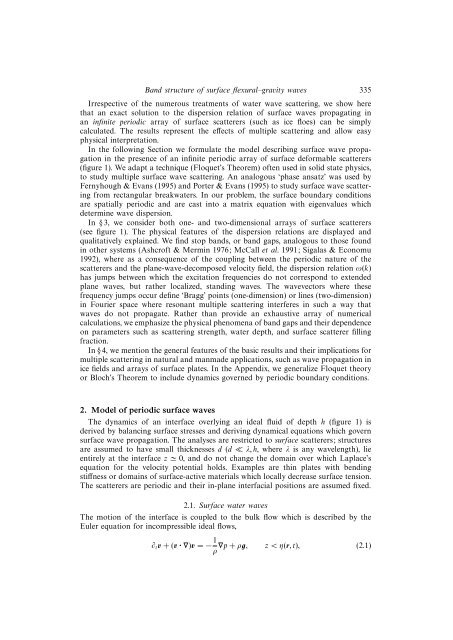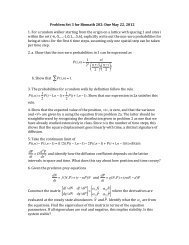J. Fluid Mech. (1998) - UCLA Department of Biomathematics
J. Fluid Mech. (1998) - UCLA Department of Biomathematics
J. Fluid Mech. (1998) - UCLA Department of Biomathematics
You also want an ePaper? Increase the reach of your titles
YUMPU automatically turns print PDFs into web optimized ePapers that Google loves.
Band structure <strong>of</strong> surface flexural–gravity waves 335Irrespective <strong>of</strong> the numerous treatments <strong>of</strong> water wave scattering, we show herethat an exact solution to the dispersion relation <strong>of</strong> surface waves propagating inan infinite periodic array <strong>of</strong> surface scatterers (such as ice floes) can be simplycalculated. The results represent the effects <strong>of</strong> multiple scattering and allow easyphysical interpretation.In the following Section we formulate the model describing surface wave propagationin the presence <strong>of</strong> an infinite periodic array <strong>of</strong> surface deformable scatterers(figure 1). We adapt a technique (Floquet’s Theorem) <strong>of</strong>ten used in solid state physics,to study multiple surface wave scattering. An analogous ‘phase ansatz’ was used byFernyhough & Evans (1995) and Porter & Evans (1995) to study surface wave scatteringfrom rectangular breakwaters. In our problem, the surface boundary conditionsare spatially periodic and are cast into a matrix equation with eigenvalues whichdetermine wave dispersion.In § 3, we consider both one- and two-dimensional arrays <strong>of</strong> surface scatterers(see figure 1). The physical features <strong>of</strong> the dispersion relations are displayed andqualitatively explained. We find stop bands, or band gaps, analogous to those foundin other systems (Ashcr<strong>of</strong>t & Mermin 1976; McCall et al. 1991; Sigalas & Economu1992), where as a consequence <strong>of</strong> the coupling between the periodic nature <strong>of</strong> thescatterers and the plane-wave-decomposed velocity field, the dispersion relation ω(k)has jumps between which the excitation frequencies do not correspond to extendedplane waves, but rather localized, standing waves. The wavevectors where thesefrequency jumps occur define ‘Bragg’ points (one-dimension) or lines (two-dimension)in Fourier space where resonant multiple scattering interferes in such a way thatwaves do not propagate. Rather than provide an exhaustive array <strong>of</strong> numericalcalculations, we emphasize the physical phenomena <strong>of</strong> band gaps and their dependenceon parameters such as scattering strength, water depth, and surface scatterer fillingfraction.In § 4, we mention the general features <strong>of</strong> the basic results and their implications formultiple scattering in natural and manmade applications, such as wave propagation inice fields and arrays <strong>of</strong> surface plates. In the Appendix, we generalize Floquet theoryor Bloch’s Theorem to include dynamics governed by periodic boundary conditions.2. Model <strong>of</strong> periodic surface wavesThe dynamics <strong>of</strong> an interface overlying an ideal fluid <strong>of</strong> depth h (figure 1) isderived by balancing surface stresses and deriving dynamical equations which governsurface wave propagation. The analyses are restricted to surface scatterers; structuresare assumed to have small thicknesses d (d ≪ λ, h, where λ is any wavelength), lieentirely at the interface z ≃ 0, and do not change the domain over which Laplace’sequation for the velocity potential holds. Examples are thin plates with bendingstiffness or domains <strong>of</strong> surface-active materials which locally decrease surface tension.The scatterers are periodic and their in-plane interfacial positions are assumed fixed.2.1. Surface water wavesThe motion <strong>of</strong> the interface is coupled to the bulk flow which is described by theEuler equation for incompressible ideal flows,∂ t v +(v·∇)v=− 1 ∇p+ρg, z < η(r,t), (2.1)ρ




